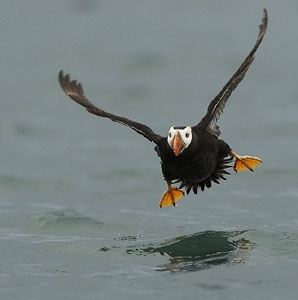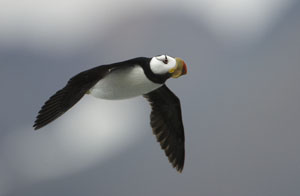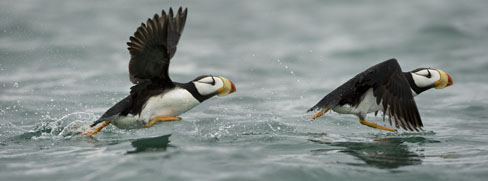

Prior to our Alaska trip we'd heard a lot of rumors and discussions about Canon's newest pro camera, the 1D Mark III. Needless to say, we were a bit concerned going into an important trip where we were hoping to use the Mark IIIs as our principle cameras. Prior to going, I had done a test, photographing our IT guy, Abe Landis, riding his bicycle towards me as I followed him in with a 500mm lens mounted on my camera and then on Mary's. Operator error can be a problem with those tests, but I felt that Mary's camera (received about a month after I got mine - and not as a freebe from Canon, either!) was very accurate with the focus. Mine ... I wasn't as sure, but when I retested the lens with my reliable 1D Mark II, I felt that I had similar results. So we trusted the camera ... somewhat.
 On
one of our Katmai bear trips we had the opportunity to photograph
tufted and horned puffins as they either lifted off the water
at our approach in a bobbing skiff, or flying like rockets toward
us as they returned to their nesting sites on a small island.
For the latter we were seated on firm ground and used our Wimberley
gimbal heads to follow the birds. Even then, my hands and fingers
were cramping up, and I think they were doing so simply because
of the stress and fatigue involved in repeatedly following the
birds. It was almost funny -- scores of birds would sometimes
swoop in a loose, circling flock, zipping in sometimes faster
than we could get a lens on them.
On
one of our Katmai bear trips we had the opportunity to photograph
tufted and horned puffins as they either lifted off the water
at our approach in a bobbing skiff, or flying like rockets toward
us as they returned to their nesting sites on a small island.
For the latter we were seated on firm ground and used our Wimberley
gimbal heads to follow the birds. Even then, my hands and fingers
were cramping up, and I think they were doing so simply because
of the stress and fatigue involved in repeatedly following the
birds. It was almost funny -- scores of birds would sometimes
swoop in a loose, circling flock, zipping in sometimes faster
than we could get a lens on them.
The original RAW file of this was rather dark and contrasty, as I shot this Horned Puffin late in the shoot when the light was really failing. The ISO was 1250, giving me 1/600th's of a second for the shutter speed. As a 5x7 or perhaps even an 8x10 the image will look quite good.
 The
boat shooting was probably even more difficult, as we had to hand-hold
our 500mm's and either sit, kneel, or squat to keep below the
view of other photographers in our skiff. Mary tired quickly,
holding up the 500, so she rested the front of the lens on the
side of the boat as a support, and used that as a turret to follow
the birds. In this way, she nailed the tufted puffin at the top
of this page.
The
boat shooting was probably even more difficult, as we had to hand-hold
our 500mm's and either sit, kneel, or squat to keep below the
view of other photographers in our skiff. Mary tired quickly,
holding up the 500, so she rested the front of the lens on the
side of the boat as a support, and used that as a turret to follow
the birds. In this way, she nailed the tufted puffin at the top
of this page.
I continued to hand-hold, and when I got the bird within the frame in sufficient time, I tool captured some nice shots. This one is a composite of two shots milli-seconds apart, at the camera's fastest frame rate of 10fps.
The shutter speed for these was 1/4000th, with an ISO of 400.
While we're still in the process of editing our running brown bears (see the Brown Bear Trip Report), I'm pretty confident that I'll be happy with the focus on those images as well. So, does the Mark III's AF work? We certainly think so!
What is our initial
Digital Workflow?
What is our Digital
Workflow in the Lab?
How
do I keep track of Digital Files?
Is Shooting in the RAW
format worthwhile?
What
is the Difference?
How can you capture
a sharp image and angel hair on a windy day?
Can you match
the Histograms?
How
do we meter White?
Is the Mark
II the ultimate wildlife digital camera?
What
is DEC?
Wildlife
Models - Is there anything new to shoot?
Do
You Need a Big Printer?
Can
a Wimberley Head be used with small lenses?
What
is Reality? Adobe's powerful LIGHTROOM Program
Why
must you have at least 2 digital backups?
Is Digital Manipulation
- a benign alternative to interacting in the natural world?
Film
or Digital? - Why
you should shoot film!
Does the Visibledust
cleaning system really work?
Which
Macro Lens is for You?
What is the Most Important thing you can do before a Workshop?
How
many Flashes do you need to effectively illuminate hummingbirds?
What
is the best shutter speed for panning running mammals?
Is
there an easy way to level a camera for panorama shots?
Is
the New Wimberley head worth having?
Is an L-Shaped Camera
Bracket worth the Money? You bet it is!
Using Zoom
lenses with tele-converters and extension tubes -- can you use
both together?
Are Image Stabilization
Lenses Worth the Money?
What
the heck is the Scheimpflug Law?
What
is the Best Composition?
Should
you have a depth of field Preview button on your camera?
How
do you determine distances?
Hyperfocal Distance
Apertures
for Macro
Flash and
Tele-flash Techniques
What
is the best flash for closeup and macro photography?
What is the
most versatile remote release camera firing system?
How
do you shoot high-speed action images?
How
did I shoot the gliding Sugar Glider?
How did I
photograph that flying wasp?
What the
heck is a Plamp?
What
I did on my summer 'vacation.'
Why is Yellowstone the best for wildlife photography in the US?
Is
a Trip to Antarctica Worth it?
What is the best season
to do a photo safari in East Africa?
What is the Big Lie?
The truth about Kenya's Tourism--it is SAFE!
Which Mountain
Park is better for wildlife - Denali or Torres del Paine?
What
are our Five Favorite Shooting Locales?
How can you
attract insectivorous birds to your feeding stations and bait
sites?
How do you
make things happen in wildlife photography?
What is the
best Car Window Mount?
How
can you save your shoulders?
How can you reduce
contrast and the effect of wind for flower and macro photography?
How can you reduce
contrast and the effect of wind for flower and macro photography?
What
is the best Game Caller?
How Easy
is Whale Photography?
How Easy is Whale Photography?
Why
Can't You Feed A Bear?
What is our
Favorite bird-shooting location?